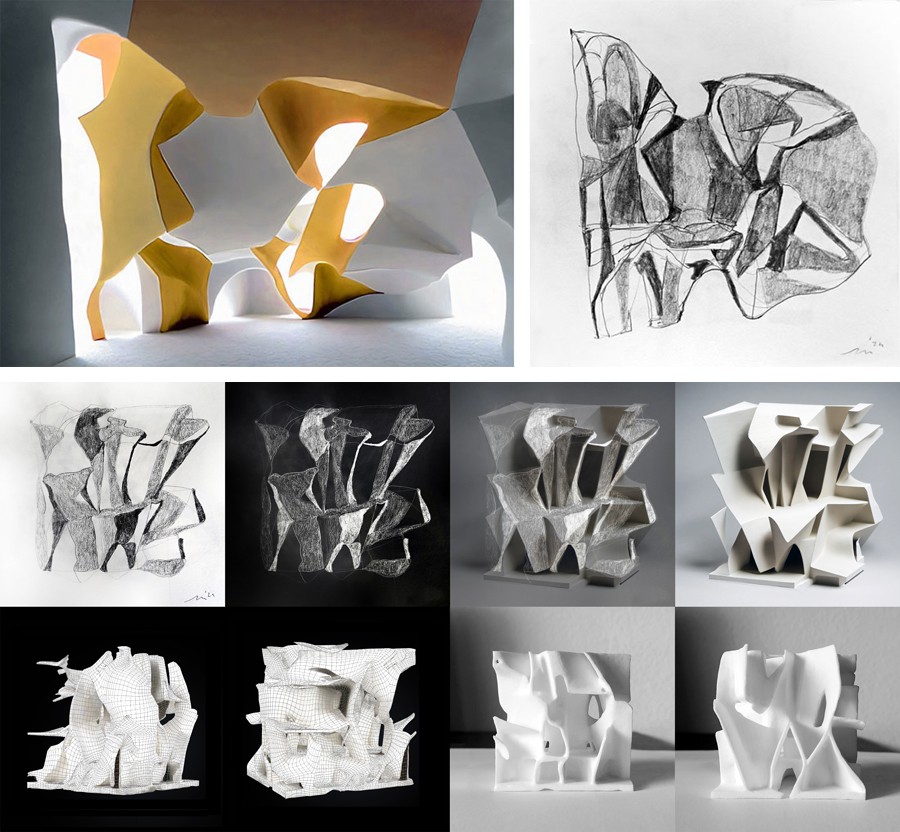Hybrid Artefacts
Transforming Abstract Drawings into Generated Architectures
With the rise of generative tools, there has been a sudden confusion regarding the basic understanding of what Art & Design Artefacts are and may become in the near future. In these turbulent times, it has become apparent that some creatives, eager to use these generative tools, are beginning to create things that cannot be accurately categorised within the known realm of Art & Design Artefacts. A new sub-category of artefact has emerged: non-physical objects that are dematerialised yet appear real, forming a distorted spatial realm. These artefacts, which do not exist in pure reality, are partly human - partly fictional, echoing the sounds of an imaginary Piranesian playground.
The generated output initially appears as simple sensory impressions, lacking the original authorship of a human creator. Subsequently, a {Human} touch, automatic drawings, coded images with unknown {hidden content}, are incorporated and used as a synthesising guide. Through pre-defined, repetitive instructions, the AI image generator transforms the abstract drawings into ensembles of images. The result is a carefully selected body, a curated slice of the whole, shining through these abstract, non-representational experiments.
{Human} drawings and {Artificial} generations seem unrelated. Drawings are human, and generations are artificial. But when we merge the two, we find ourselves in a contradiction. What seemed distinct and separate has suddenly fused into a chaotic, yet occasionally pleasing, entanglement of forms. The decoded output {generated data} reveals instances of artistic expression which, at irregular intervals, transform the abstract input into more elaborate organic three-dimensional structures. These are Hybrid Artefacts, born and co-authored at the intersection of human intuition and machine logic, occupying a liminal domain that reconfigures traditional notions of creative agency.
To further narrow down the range of latent space in which the generations occur, a personalised ranking {tier list} of generations produced with slightly different prompts is created, prioritising the most peculiar results. The parameters and settings intuitively discovered to produce these novel images are then modelled into a virtual machine: a series of sequentially operating notes through which the transformations materialise. The resulting script serves as the basis for a more effective and streamlined workflow, while still retaining a desired degree of chaotic behaviour {hallucination}.
In the final stage of the research, a series of exploratory case studies is conducted to place the initial findings in the broader context of the state of the art. These studies serve as both a reflection on, and an extension of the original experiment and are conducted in three different ways. (1) Constructing speculative narratives around the non-referential, generative Hybrid Artefacts. (2) Replicating the experiment using externally sourced abstract drawings by Friedrich Kiesler & Hermann Finsterlin as input. (3) Through a double transformation process; the abstract drawing is first transformed into an image of an artificial 3D model, and then transformed again using an additional generative tool, but this time into actual 3D models that are materialised as physical 3D printed objects.
(1) Compositional Affects in Generated Images: An Examination
(2) Morphological Transformers: Automatic Drawing into Synthesised Visual Representations
(3) Metamorphix: Curated from a Sampling Set of Personalized Generations
(4) Framework Definition: Exploratory Case Studies
(5) Reflecting on Spatial Form-Finding with AI: Key Insights & A Vision for the Future
[Exhibit A] Future Worlds
Keywords: multidimensional, latent spaces, compositional affects, prompt playing, looping problems, purifiers, deep learning models, generative process, diffusion, distortion, compression, biases in datasets, compilations, fine-tuning, transformers, infinite possibilities, curation, originality.
Ⓜ Marcel Moonen, PhD researcher, Design Based Doctorate, TU Berlin, 2023 - 2026, Hybrid Artefacts [EDUCATIONAL PURPOSE ONLY] M. Production